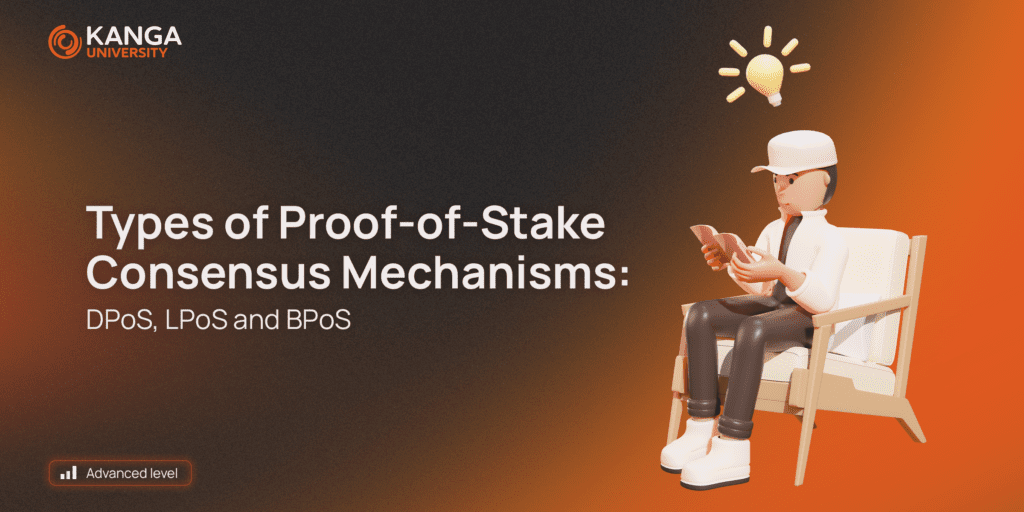
You have surely heard of the Proof-of-Stake (PoS) consensus more than once. It is one of the most popular algorithms used by blockchain networks. Understanding how it works and what makes it different will make it easier for you to understand how the blockchain you are using works. There are different types of PoS, but they all have a similar concept. In today’s lesson, we will discuss what PoS is and introduce you to the main variants: DPoS, LPoS and BPoS
Proof-of-Stake
It was first described by Sunny King and Scott Nadal in 2012. It assumes that the more coins a miner owns, the more mining power he has. This reduces the computational effort required to verify blocks and transactions.
The miners, as owners of the coins, offer them as collateral for the possibility of verification. In crypto language, they are called validators. The validators are chosen at random and their job is to mine or validate the block.
PoS randomly selects who will extract the block. It is not based on a competition like the proof-of-work algorithm. Proof-of-Stake helps blockchains to synchronize data, verify information and process transactions. It is very effective and helpful in managing blockchains.
Delegated Proof-of-Stake (DPoS).
It works very much like the PoS consensus. The difference is that it uses a voting and delegation mechanism that encourages users to secure networks in the form of rates.
How it works. Users spend their coins online to vote for different delegates. Those who are elected make the most important decisions that apply to the entire ecosystem. They can even set the rules of a particular protocol or approve transactions.
DPoS is the most efficient consensus mechanism. It ensures the durability and scalability of the blockchain while eliminating the need for the mining process. Therefore, it does not consume as much energy as, for example, proof-of-work.
Interesting fact: Delegates are very often called block producers or block witnesses.
Advantages of DPoS
- The “delegated” voting system is fast.
- The parallelism achieved by DPoS provides high performance and scalability
- It reduces the cost of maintaining network security.
- It optimizes the use of network resources, such as bandwidth and CPU.
Disadvantages of DPoS
- Its success requires the participation and coordination of a truly interested community for effective governance.
- DPoS exposes the blockchain to problems with the voting system
- Some critics of the DPoS model claim that the protocol promotes centralization.
Liquid Proof of Stake (LPoS)
LPoS sounds very similar to the DPoS consensus in its description. As a cryptocurrency holder, with the LPoS consensus, you lend your validation rights to other users without having to give up ownership of your assets. It is up to you to decide who you transfer ownership to or who you entrust with your cryptocurrency. It is important to note that the number of active validation nodes in the LPoS consensus is very dynamic, and the validators are not fixed. For example, if you have many assets, you can become a block validator without needing outside approval. Users with fewer assets can support you or form a profitable coalition with you. And thanks to the fact that in LPoS the number of active nodes is dynamic, it is impossible for the majority to take over the network.
Bonded Proof-of-Stake (BPoS).
You will probably not be surprised when we say that the BPoS is similar to the LPoS. Again, delegation is not mandatory and the holders of more assets have a say in the protocol. There is only a basic framework. In the event of a security or liveness failure, a certain portion of the validators’ and delegates’ income is cut off for the network. Despite this drawback, this type of consensus eliminates the share factor present in LPoS. Projects that have implemented this algorithm include Cosmos and IRIS net.
Summary
PoS consensus mechanisms will continue to change, and their number will grow steadily. This is because the developers of ecosystems based on the blockchain will combine them to manage the chain even more efficiently.
The consensus and working algorithms described will certainly expand your horizons. Every project based on the Blockchain implements some form of proof-of-stake consensus mechanism. Everything is geared towards streamlining the processes.